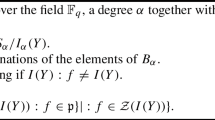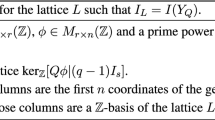Abstract
Toric codes are a class of m-dimensional cyclic codes introduced recently by Hansen (Coding theory, cryptography and related areas (Guanajuato, 1998), pp 132–142, Springer, Berlin, 2000; Appl Algebra Eng Commun Comput 13:289–300, 2002), and studied in Joyner (Appl Algebra Eng Commun Comput 15:63–79, 2004) and Little and Schenck (SIAM Discrete Math, 2007). They may be defined as evaluation codes obtained from monomials corresponding to integer lattice points in an integral convex polytope \(P \subseteq {\mathbb{R}}^m\) . As such, they are in a sense a natural extension of Reed–Solomon codes. Several articles cited above use intersection theory on toric varieties to derive bounds on the minimum distance of some toric codes. In this paper, we will provide a more elementary approach that applies equally well to many toric codes for all \(m \ge 2\) . Our methods are based on a sort of multivariate generalization of Vandermonde determinants that has also been used in the study of multivariate polynomial interpolation. We use these Vandermonde determinants to determine the minimum distance of toric codes from simplices and rectangular polytopes. We also prove a general result showing that if there is a unimodular integer affine transformation taking one polytope P 1 to a second polytope P 2, then the corresponding toric codes are monomially equivalent (hence have the same parameters). We use this to begin a classification of two-dimensional cyclic toric codes with small dimension.
Similar content being viewed by others
References
Aubry Y., Perret M. (1996). A Weil theorem for singular curves. In: Pellikaan, R., Perret, M., Vladut, S.G. (eds) Arithmetic Geometry and Coding Theory, pp 1–7. de Gruyter, Berlin
Beelen P., Pellikaan R. (2000). The Newton polygon of plane curves with many rational points. Des. Codes Cryptogr. 21: 41–67
Brouwer, A.E.: Bounds on linear codes. In: Handbook of Coding Theory, pp. 295–461. Elsevier, Amsterdam (1998), and online updates at http://www.win.tue.nl/~aeb/voorlincod.html
Chui, C.K., Lai, M.J.: Vandermonde determinant and Lagrange interpolation in \({\mathbb{R}}^s\) . In: Nonlinear and convex analysis (Santa Barbara, California, 1985), pp. 23–35. Lecture Notes in Pure and Appl. Math., vol. 107. Dekker, New York (1987)
Gasca M., Sauer T. (2000). Polynomial interpolation in several variables. Multivariate polynomial interpolation. Adv. Comput. Math. 12: 377–410
Hansen, J.: Toric surfaces and error-correcting codes. In: Coding Theory, Cryptography And Related Areas (Guanajuato, 1998), pp. 132–142. Springer, Berlin (2000)
Hansen J. (2002). Toric varieties Hirzebruch surfaces and error-correcting codes. Appl. Algebra Eng. Commun. Comput. 13: 289–300
Joyner D. (2004). Toric codes over finite fields. Appl. Algebra Eng. Commun. Comput. 15: 63–79
Little J., Schenck H. (2006). Toric surface codes and Minkowski sums. SIAM J. Discrete Math. 20: 999–1014
Ziegler G. (1995). Lectures on Polytopes. Springer, Berlin
Author information
Authors and Affiliations
Corresponding author
Rights and permissions
About this article
Cite this article
Little, J., Schwarz, R. On toric codes and multivariate Vandermonde matrices. AAECC 18, 349–367 (2007). https://doi.org/10.1007/s00200-007-0041-1
Received:
Revised:
Published:
Issue Date:
DOI: https://doi.org/10.1007/s00200-007-0041-1




